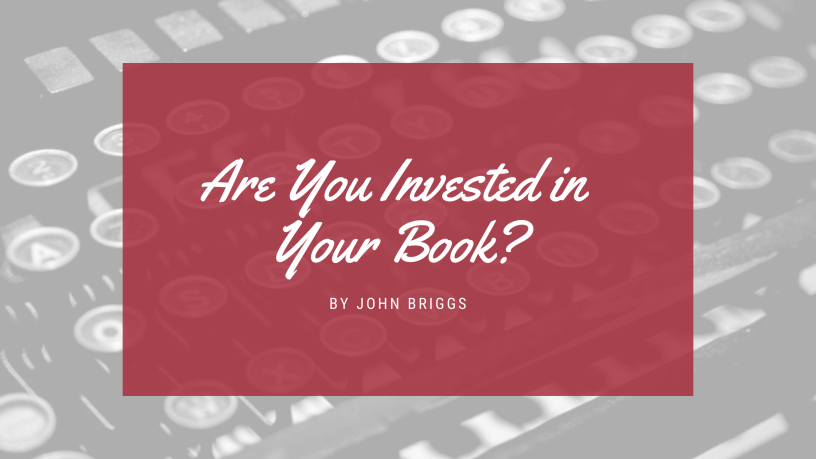When you finish writing your book, few people will doubt you’re committed to your writing. You’ve spent months or years putting it on paper, and hopefully poured your heart into every word. If the work is personal enough, you’ve invested a great deal of yourself. If nothing else, you’ve invested your time and talent.
But now that it’s done, are you truly invested in making your book a success?
Your investment in traditional publishing
Let’s start with the less obvious of the two types of publishing. How much can traditional publishing cost you if you’re getting paid for your book?
The honest answer? Thousands.
It may not be that high, but you do have costs in paper, manuscript boxes, and postage for any publishers and agents who don’t yet accept email submissions. You may also find that you have to attend writers conferences to get access to certain publishers. While agents are generally open to submissions, meeting them at a conference can make you stick out in their mind.
There are possible other expenses like buying a domain name and building a website, or hiring a copy editor to get your book in better shape to send to a potential buyer. And then, of course, there’s all that time you spend writing, rewriting, sending it out and waiting for a response – but at the very least, if you’re not self-publishing, you should have more time to write. You may also have travel costs to book signings, speaking engagements, book fairs, etc.
Total cost: A hundred to several thousand.
Return: You will likely get your money back on your advance, but that’s a maybe. It depends how large your advance is and how much you spend to get it accepted. You might just be lucky to break even.
[Want a second pair of eyes? Check out our proofreading service.]
Your investment in self-publishing
This is the more obvious way to invest in your writing.
- Editing. Every self-published book should at least be proofread by a professional. Preferably it should get a content edit first, but you definitely can’t let it go to press without a proofread. Several hundred dollars to a thousand plus.
- Cover Design. Your book needs a professional cover. If you have graphic design skills or know someone who does, fantastic! If not, hire a professional. Don’t let your cousin Bob do it. If you’re book isn’t eye-catching, it won’t sell. You shouldn’t judge a book by its cover, but people do. All the time. Your book has to look good on a shelf or as a thumbnail. Hire a professional. One hundred dollars to a thousand plus.
- ISBN. Depending upon who publishes your book, this might be included in the cost, or they might have a small fee. If you buy an ISBN yourself (plus the barcode for a printed book), it will cost you $200, though if you can, buy ten of them for almost the same price. Free to $500.
- Marketing. There are free ways to market your book (Facebook, Goodreads, Twitter, email blasts, blogging, etc.), but you should set aside a few bucks to market your book. At the very least, you’ll need a few reviewer copies to give away, plus any free copies for contests, etc. Free to $1,000.
- Time. You’ll need to spend even more of this than if you go the traditional route. After all, not only do you have to write it, you’ll have to upload it to your publisher, possibly format it for ebook publishing, and market it.
- Travel. As with traditional publishing, you have to attend book signings, book fairs, and more. You’ll likely have fewer than if you traditionally publish (though not necessarily, given how little publishers now handle this aspect of your career), but you’ll definitely have some travel expenses when it comes to self-publishing. A tank of gas to hundreds of dollars.
Total cost: If you do it on the cheap, a few hundred dollars, but to do it right, expect to spend around $1,000.
Return: Most self-published books do not pay out. The average self-published book sells 100 copies. For most people, 300 books is the tipping point to profit.
No matter how you publish, it’s going to cost you something, but the true writer accepts this as the cost of doing business. You’ll invest a little bit of your money, but a lot of yourself. Holding that book in your hand, though, makes it all worthwhile. Good luck!
This guest post was contributed by John Briggs. John has been a writer for nearly 20 years, starting out in newspapers and eventually spent several years as a nationally syndicated children’s TV critic. His book, Leaping Lemmings, is coming out Sept 6th, 2016.


Thank you for sharing.
LikeLike
Writing a book is a commitment of time and effort. It’s not easy, but it’s worth it in the end to know what you’ve accomplished. Your book reaching even a single reader is an accomplishment. Thank you for sharing your insights.
LikeLike
Thank you for sharing this, as someone who has tried writing many times this helpful in my process
LikeLike
No one wants to think about how much it costs in money. I like to remind folks how much it costs in personal time, effort, (blood, sweat, tears) to just write it. That’s the priceless part.
LikeLike